Deck 1: Economics: the Study of Opportunity Cost
Question
Question
Question
Question
Question
Question
Question
Question
Question
Question
Question
Question
Question
Question
Question
Question
Question
Question
Question
Question
Question
Question
Question
Question
Question
Question
Question
Question
Question
Question
Question
Question
Question
Question
Question
Question
Question
Question
Question
Question
Question
Question
Question
Question
Question
Question
Question
Question
Question
Question
Question
Question
Question
Question
Question
Question
Question
Question
Question
Question
Question
Question
Question
Question
Question
Question
Question
Question
Question
Question
Question
Question
Question
Question
Question
Question
Question
Question
Question
Question

Unlock Deck
Sign up to unlock the cards in this deck!
Unlock Deck
Unlock Deck
1/124
Play
Full screen (f)
Deck 1: Economics: the Study of Opportunity Cost
1
The fact that the production possibilities frontier is bowed out indicates there is
A)scarcity.
B)constant opportunity cost.
C)unemployment.
D)increasing opportunity cost.
A)scarcity.
B)constant opportunity cost.
C)unemployment.
D)increasing opportunity cost.
D
2
A production possibilities frontier is a simple model of
A)scarcity and allocation.
B)prices and output.
C)production and costs.
D)inputs and outputs.
A)scarcity and allocation.
B)prices and output.
C)production and costs.
D)inputs and outputs.
A
3
The underlying reason production possibilities frontiers are likely to be bowed out (rather than linear)is
A)choices have consequences.
B)there is always opportunity costs.
C)some resources and people can be better used producing one good rather than another.
D)there is always some level of unemployment.
A)choices have consequences.
B)there is always opportunity costs.
C)some resources and people can be better used producing one good rather than another.
D)there is always some level of unemployment.
C
4
Points outside the Production Possibilities Frontier are
A)attainable.
B)unattainable.
C)associated with some unemployment.
D)both attainable and unattainable.
A)attainable.
B)unattainable.
C)associated with some unemployment.
D)both attainable and unattainable.

Unlock Deck
Unlock for access to all 124 flashcards in this deck.
Unlock Deck
k this deck
5
The optimization assumption suggests that people make
A)irrational decisions.
B)unpredictable decisions.
C)decisions to make themselves as well off as possible.
D)decisions without thinking very hard.
A)irrational decisions.
B)unpredictable decisions.
C)decisions to make themselves as well off as possible.
D)decisions without thinking very hard.

Unlock Deck
Unlock for access to all 124 flashcards in this deck.
Unlock Deck
k this deck
6
The one word in the definition of economics that focuses on the fact that we have to make choices about who gets what and how much is
A)scarcity.
B)resources.
C)study.
D)allocation.
A)scarcity.
B)resources.
C)study.
D)allocation.

Unlock Deck
Unlock for access to all 124 flashcards in this deck.
Unlock Deck
k this deck
7
Scarcity implies that the allocation scheme chosen by society can
A)not make more of any one good.
B)typically make more of a good but at the expense of making less of another.
C)always make more of all goods simultaneously.
A)not make more of any one good.
B)typically make more of a good but at the expense of making less of another.
C)always make more of all goods simultaneously.

Unlock Deck
Unlock for access to all 124 flashcards in this deck.
Unlock Deck
k this deck
8
The underlying reason that there are unattainable points on a production possibilities frontier diagram is that there
A)is government.
B)are always choices that have to be made.
C)is a scarcity of resources within a fixed level of technology.
D)is unemployment of resources.
A)is government.
B)are always choices that have to be made.
C)is a scarcity of resources within a fixed level of technology.
D)is unemployment of resources.

Unlock Deck
Unlock for access to all 124 flashcards in this deck.
Unlock Deck
k this deck
9
A resource
A)must come from the earth.
B)only includes physical things.
C)is anything that we consume directly or use to make things we will ultimately consume.
D)A)and C)
A)must come from the earth.
B)only includes physical things.
C)is anything that we consume directly or use to make things we will ultimately consume.
D)A)and C)

Unlock Deck
Unlock for access to all 124 flashcards in this deck.
Unlock Deck
k this deck
10
Something is scarce as long as
A)there is a price that the market puts on the item.
B)there is no freely available infinite source of the item.
C)the government provides it.
D)the market provides it.
A)there is a price that the market puts on the item.
B)there is no freely available infinite source of the item.
C)the government provides it.
D)the market provides it.

Unlock Deck
Unlock for access to all 124 flashcards in this deck.
Unlock Deck
k this deck
11
Points on the Production Possibilities Frontier are
A)attainable.
B)unattainable.
C)associated with some unemployment
D)both attainable and unattainable.
A)attainable.
B)unattainable.
C)associated with some unemployment
D)both attainable and unattainable.

Unlock Deck
Unlock for access to all 124 flashcards in this deck.
Unlock Deck
k this deck
12
If the production possibilities frontier is not bowed out but is a line, indicates there is
A)scarcity.
B)constant opportunity cost.
C)unemployment.
D)increasing opportunity cost.
A)scarcity.
B)constant opportunity cost.
C)unemployment.
D)increasing opportunity cost.

Unlock Deck
Unlock for access to all 124 flashcards in this deck.
Unlock Deck
k this deck
13
The one word in the definition of economics that focuses on the fact that it is impossible to provide all of the goods and services that everyone wants is
A)scarcity.
B)resources.
C)study.
D)allocation.
A)scarcity.
B)resources.
C)study.
D)allocation.

Unlock Deck
Unlock for access to all 124 flashcards in this deck.
Unlock Deck
k this deck
14
Points inside the Production Possibilities Frontier are
A)attainable.
B)unattainable.
C)associated with some unemployment.
D)both attainable and unattainable.
A)attainable.
B)unattainable.
C)associated with some unemployment.
D)both attainable and unattainable.

Unlock Deck
Unlock for access to all 124 flashcards in this deck.
Unlock Deck
k this deck
15
Economists focus on "unlimited human wants" rather than _____ to describe our pursuit of goods and services.
A)needs
B)prices
C)output
D)physical requirements
A)needs
B)prices
C)output
D)physical requirements

Unlock Deck
Unlock for access to all 124 flashcards in this deck.
Unlock Deck
k this deck
16
Economics is the study of
A)how much people should buy and the prices they should be willing to pay.
B)how much people should sell and the prices they should be willing to accept.
C)the allocation of the world's freely available resources and who should get them.
D)the allocation and use of scarce resources to satisfy unlimited human wants.
A)how much people should buy and the prices they should be willing to pay.
B)how much people should sell and the prices they should be willing to accept.
C)the allocation of the world's freely available resources and who should get them.
D)the allocation and use of scarce resources to satisfy unlimited human wants.

Unlock Deck
Unlock for access to all 124 flashcards in this deck.
Unlock Deck
k this deck
17
Production possibilities frontier models
A)the choices we make in setting prices.
B)the choices we make in setting output alternatives.
C)the choices we make in setting wages.
D)the choices we make in setting incomes.
A)the choices we make in setting prices.
B)the choices we make in setting output alternatives.
C)the choices we make in setting wages.
D)the choices we make in setting incomes.

Unlock Deck
Unlock for access to all 124 flashcards in this deck.
Unlock Deck
k this deck
18
A simplifying assumption is typically made so as to
A)make a point clearer by stripping away excess detail.
B)make a point clearer by adding sufficient detail to get things precise.
C)divert attention from the real problem.
D)make things look better than they really are.
A)make a point clearer by stripping away excess detail.
B)make a point clearer by adding sufficient detail to get things precise.
C)divert attention from the real problem.
D)make things look better than they really are.

Unlock Deck
Unlock for access to all 124 flashcards in this deck.
Unlock Deck
k this deck
19
The fact that we cannot operate at a point outside a production possibilities frontier indicates there is
A)scarcity.
B)constant opportunity cost.
C)unemployment.
D)increasing opportunity cost.
A)scarcity.
B)constant opportunity cost.
C)unemployment.
D)increasing opportunity cost.

Unlock Deck
Unlock for access to all 124 flashcards in this deck.
Unlock Deck
k this deck
20
The fact that we are operating at a point inside a bowed out production possibilities frontier, indicates there is
A)scarcity.
B)constant opportunity cost.
C)unemployment.
D)increasing opportunity cost.
A)scarcity.
B)constant opportunity cost.
C)unemployment.
D)increasing opportunity cost.

Unlock Deck
Unlock for access to all 124 flashcards in this deck.
Unlock Deck
k this deck
21
Using Figure 1.4 we know the production of 9 units of soda and 1 units of pizza is 
A)possible, but there would be unemployment.
B)possible, but only if all resources were fully employed.
C)impossible because we have the resources but do not have the technology.
D)impossible because we have the technology but do not have the resources.

A)possible, but there would be unemployment.
B)possible, but only if all resources were fully employed.
C)impossible because we have the resources but do not have the technology.
D)impossible because we have the technology but do not have the resources.

Unlock Deck
Unlock for access to all 124 flashcards in this deck.
Unlock Deck
k this deck
22
In Figure 1.2, which labeled point indicates that there are sufficient resources and technology to produce the combination of goods represented by that point? 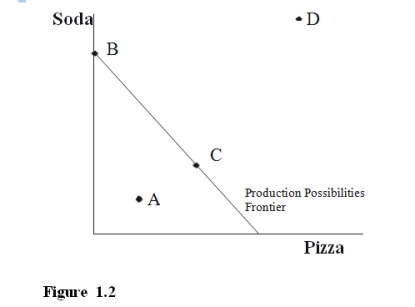
A)only A
B)only C
C)only D
D)A, B and C

A)only A
B)only C
C)only D
D)A, B and C

Unlock Deck
Unlock for access to all 124 flashcards in this deck.
Unlock Deck
k this deck
23
In Figure 1.2, which labeled points are attainable? 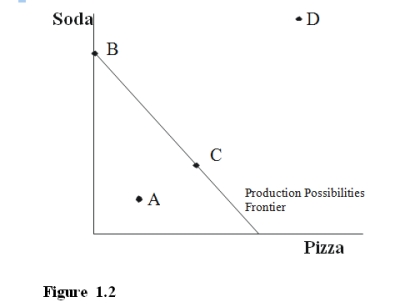
A)only A
B)only B and C
C)only D
D)A, B and C

A)only A
B)only B and C
C)only D
D)A, B and C

Unlock Deck
Unlock for access to all 124 flashcards in this deck.
Unlock Deck
k this deck
24
In Figure 1.1, which labeled points are attainable? 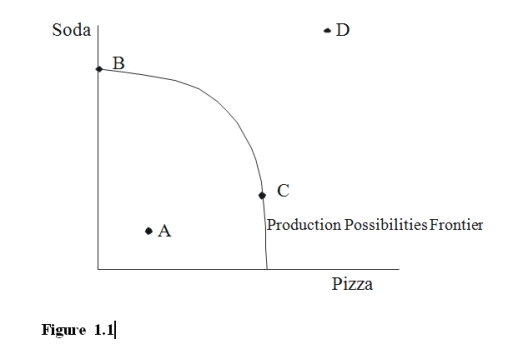
A)only A
B)only B and C
C)only D
D)A, B and C

A)only A
B)only B and C
C)only D
D)A, B and C

Unlock Deck
Unlock for access to all 124 flashcards in this deck.
Unlock Deck
k this deck
25
In Figure 1.1, which labeled point indicates that there are sufficient resources and technology to produce the combination of goods represented by that point? 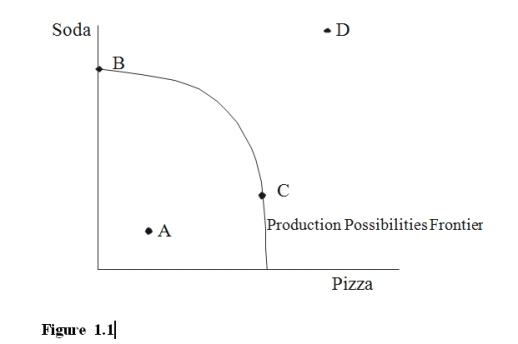
A)only A
B)only B and C
C)only D
D)A, B and C

A)only A
B)only B and C
C)only D
D)A, B and C

Unlock Deck
Unlock for access to all 124 flashcards in this deck.
Unlock Deck
k this deck
26
Using Figure 1.4 above we know the production of 9 units of soda and 3 units of pizza is 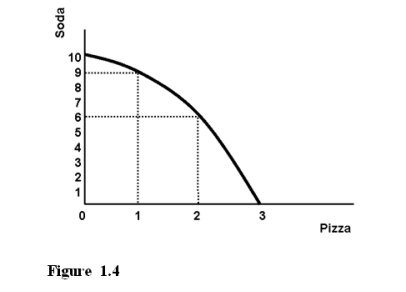
A)possible, but there would be unemployment.
B)possible, but only if all resources were fully employed.
C)impossible because we either do not have the resources or the technology.
D)undesirable.

A)possible, but there would be unemployment.
B)possible, but only if all resources were fully employed.
C)impossible because we either do not have the resources or the technology.
D)undesirable.

Unlock Deck
Unlock for access to all 124 flashcards in this deck.
Unlock Deck
k this deck
27
In Figure 1.1, which labeled points are unattainable? 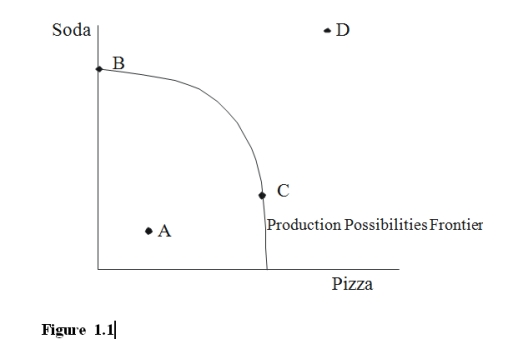
A)only A
B)only B and C
C)only D
D)A, B and C

A)only A
B)only B and C
C)only D
D)A, B and C

Unlock Deck
Unlock for access to all 124 flashcards in this deck.
Unlock Deck
k this deck
28
In Figure 1.2, which labeled points represent the existence of unemployment? 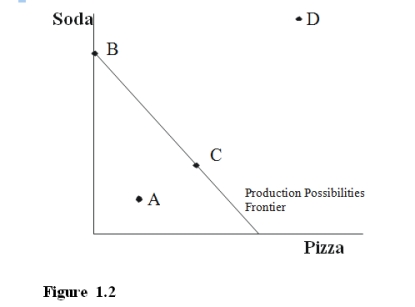
A)only A
B)only B and C
C)only D
D)A, B and C

A)only A
B)only B and C
C)only D
D)A, B and C

Unlock Deck
Unlock for access to all 124 flashcards in this deck.
Unlock Deck
k this deck
29
In Figure 1.3 A, B and C, which depicts the existence of opportunity cost? 
A)Figure A
B)Figure B
C)Figure C
D)All three figures show the existence of opportunity cost.

A)Figure A
B)Figure B
C)Figure C
D)All three figures show the existence of opportunity cost.

Unlock Deck
Unlock for access to all 124 flashcards in this deck.
Unlock Deck
k this deck
30
In Figure 1.1, which labeled points represent the existence of unemployment?  a. only A b. only B and C
a. only A b. only B and C
C) only D
D) A, B and C
 a. only A b. only B and C
a. only A b. only B and CC) only D
D) A, B and C

Unlock Deck
Unlock for access to all 124 flashcards in this deck.
Unlock Deck
k this deck
31
Using Figure 1.4 you can tell that 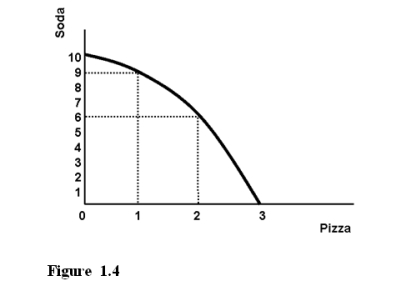
A)the technology does not exist to produce 6 units of soda and 2 unit of pizza.
B)there is unemployment.
C)there is constant opportunity cost.
D)the technology does not exist to produce 9 units of soda and 3 unit of pizza.

A)the technology does not exist to produce 6 units of soda and 2 unit of pizza.
B)there is unemployment.
C)there is constant opportunity cost.
D)the technology does not exist to produce 9 units of soda and 3 unit of pizza.

Unlock Deck
Unlock for access to all 124 flashcards in this deck.
Unlock Deck
k this deck
32
In Figure 1.1, which labeled point indicates that there are insufficient resources or technology to produce the combination of goods represented by that point? 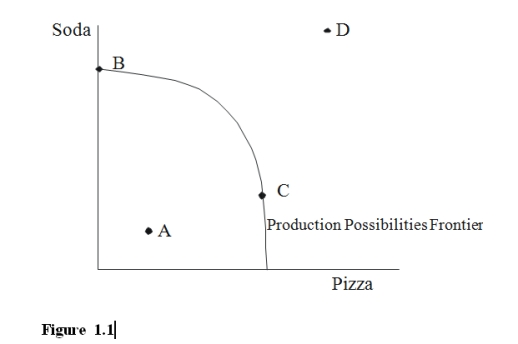
A)only A
B)only B and C
C)only D
D)A, B and C

A)only A
B)only B and C
C)only D
D)A, B and C

Unlock Deck
Unlock for access to all 124 flashcards in this deck.
Unlock Deck
k this deck
33
Using Figure 1.4 above we know the production of 4 units of soda and 2 units of pizza is 
A)possible, but there would be unemployed resources.
B)possible, but only if all resources were fully employed.
C)impossible because we have the resources but do not have the technology.
D)impossible because we have the technology but do not have the resources.

A)possible, but there would be unemployed resources.
B)possible, but only if all resources were fully employed.
C)impossible because we have the resources but do not have the technology.
D)impossible because we have the technology but do not have the resources.

Unlock Deck
Unlock for access to all 124 flashcards in this deck.
Unlock Deck
k this deck
34
In Figure 1.3 A, B and C, which depicts the existence of scarcity? 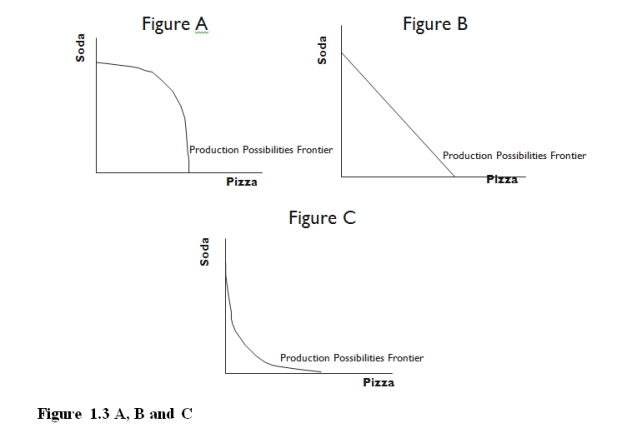
A)Figure A
B)Figure B
C)Figure C
D)All three figures show the existence of scarcity.

A)Figure A
B)Figure B
C)Figure C
D)All three figures show the existence of scarcity.

Unlock Deck
Unlock for access to all 124 flashcards in this deck.
Unlock Deck
k this deck
35
Using Figure 1.4 you can tell that 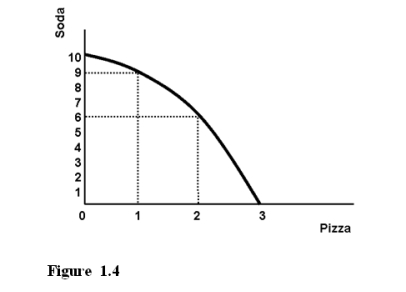
A)there is increasing opportunity cost.
B)there is unemployment.
C)there is constant opportunity cost.
D)the technology does not exist to produce 9 units of soda and 1 unit of pizza.

A)there is increasing opportunity cost.
B)there is unemployment.
C)there is constant opportunity cost.
D)the technology does not exist to produce 9 units of soda and 1 unit of pizza.

Unlock Deck
Unlock for access to all 124 flashcards in this deck.
Unlock Deck
k this deck
36
In Figure 1.2, which labeled points are unattainable? 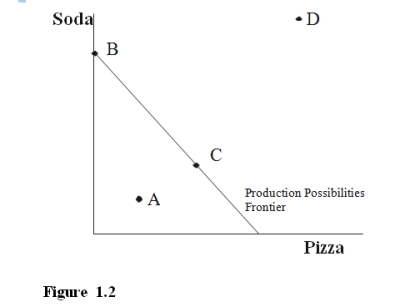
A)only A
B)only B and C
C)only D
D)A, B and C

A)only A
B)only B and C
C)only D
D)A, B and C

Unlock Deck
Unlock for access to all 124 flashcards in this deck.
Unlock Deck
k this deck
37
In Figure 1.3 A, B and C, which depicts the existence of increasing opportunity cost? 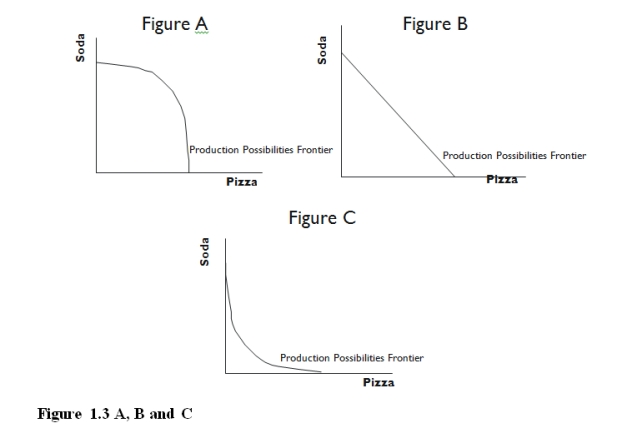
A)Figure A
B)Figure B
C)Figure C
D)All three figures show the existence of increasing opportunity cost.

A)Figure A
B)Figure B
C)Figure C
D)All three figures show the existence of increasing opportunity cost.

Unlock Deck
Unlock for access to all 124 flashcards in this deck.
Unlock Deck
k this deck
38
In Figure 1.3 A, B and C, which depicts the existence of constant opportunity cost? 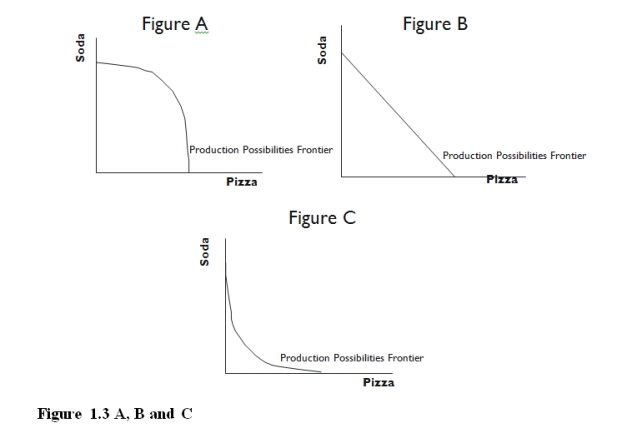
A)Figure A
B)Figure B
C)Figure C
D)All three figures show the existence of constant opportunity cost.

A)Figure A
B)Figure B
C)Figure C
D)All three figures show the existence of constant opportunity cost.

Unlock Deck
Unlock for access to all 124 flashcards in this deck.
Unlock Deck
k this deck
39
In Figure 1.2, which labeled point indicates that there are insufficient resources or technology to produce the combination of goods represented by that point? 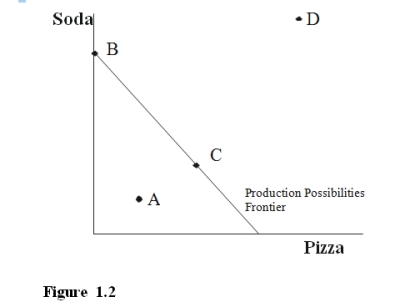
A)only A
B)only C
C)only D
D)A, B and C

A)only A
B)only C
C)only D
D)A, B and C

Unlock Deck
Unlock for access to all 124 flashcards in this deck.
Unlock Deck
k this deck
40
Using Figure 1.4 we know the production of 6 units of soda and 2 units of pizza is 
A)possible, but there would be unemployment.
B)possible, but only if all resources were fully employed.
C)impossible because we have the resources but do not have the technology.
D)impossible because we have the technology but do not have the resources.

A)possible, but there would be unemployment.
B)possible, but only if all resources were fully employed.
C)impossible because we have the resources but do not have the technology.
D)impossible because we have the technology but do not have the resources.

Unlock Deck
Unlock for access to all 124 flashcards in this deck.
Unlock Deck
k this deck
41
Referring to Figure 1.4, the opportunity cost of producing the first unit of pizza is 
A)one unit of soda.
B)three units of soda.
C)six units of soda.
D)the same as the opportunity cost of producing the second unit of pizza.

A)one unit of soda.
B)three units of soda.
C)six units of soda.
D)the same as the opportunity cost of producing the second unit of pizza.

Unlock Deck
Unlock for access to all 124 flashcards in this deck.
Unlock Deck
k this deck
42
Using Figure 1.7 you can tell that 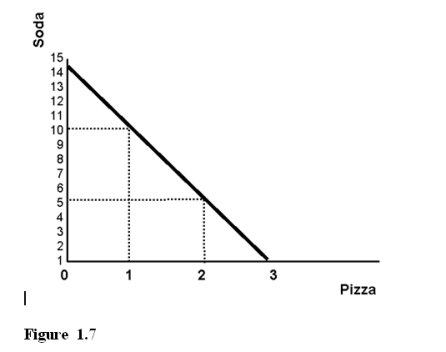
A)the technology does not exist to produce 5 units of soda and 3 units of pizza.
B)there is unemployment.
C)there is increasing opportunity cost.
D)the technology does not exist to produce 10 units of soda and 1 units of pizza.

A)the technology does not exist to produce 5 units of soda and 3 units of pizza.
B)there is unemployment.
C)there is increasing opportunity cost.
D)the technology does not exist to produce 10 units of soda and 1 units of pizza.

Unlock Deck
Unlock for access to all 124 flashcards in this deck.
Unlock Deck
k this deck
43
Using Figure 1.6 you can tell that 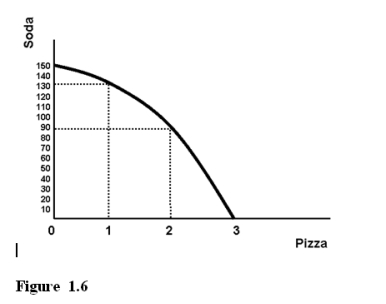
A)there is increasing opportunity cost.
B)there is unemployment.
C)there is constant opportunity cost.
D)the technology does not exist to produce 90 units of soda and 2 units of pizza.

A)there is increasing opportunity cost.
B)there is unemployment.
C)there is constant opportunity cost.
D)the technology does not exist to produce 90 units of soda and 2 units of pizza.

Unlock Deck
Unlock for access to all 124 flashcards in this deck.
Unlock Deck
k this deck
44
Using Figure 1.5 above we know the production of 6 units of soda and 1 unit of pizza is 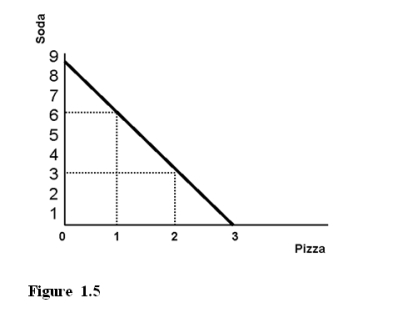
A)possible, but there would be unemployed resources.
B)possible, but only if all resources were fully employed.
C)impossible because we have the resources but do not have the technology.
D)impossible because we have the technology but do not have the resources.

A)possible, but there would be unemployed resources.
B)possible, but only if all resources were fully employed.
C)impossible because we have the resources but do not have the technology.
D)impossible because we have the technology but do not have the resources.

Unlock Deck
Unlock for access to all 124 flashcards in this deck.
Unlock Deck
k this deck
45
Using Figure 1.7 you can tell that 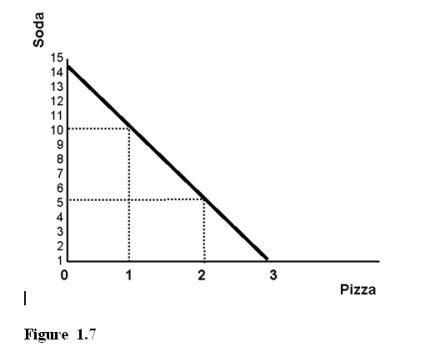
A)there is increasing opportunity cost.
B)there is unemployment.
C)there is constant opportunity cost.
D)the technology does not exist to produce 10 units of soda and 1 unit of pizza.

A)there is increasing opportunity cost.
B)there is unemployment.
C)there is constant opportunity cost.
D)the technology does not exist to produce 10 units of soda and 1 unit of pizza.

Unlock Deck
Unlock for access to all 124 flashcards in this deck.
Unlock Deck
k this deck
46
Using Figure 1.6 we know the production of 130 units of soda and 1 unit of pizza is 
A)possible, but there would be unemployed resources.
B)possible, but only if all resources were fully employed.
C)impossible because we have the resources but do not have the technology.
D)impossible because we have the technology but do not have the resources.

A)possible, but there would be unemployed resources.
B)possible, but only if all resources were fully employed.
C)impossible because we have the resources but do not have the technology.
D)impossible because we have the technology but do not have the resources.

Unlock Deck
Unlock for access to all 124 flashcards in this deck.
Unlock Deck
k this deck
47
Using Figure 1.6 we know the production of 90 units of soda and 2 units of pizza is 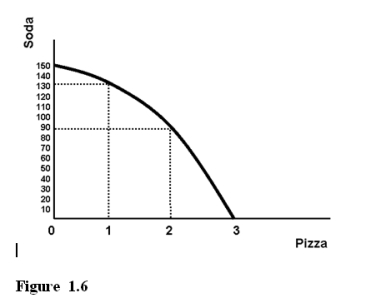
A)possible, but there would be unemployed resources.
B)possible, but only if all resources were fully employed.
C)impossible because we have the resources but do not have the technology.
D)impossible because we have the technology but do not have the resources.

A)possible, but there would be unemployed resources.
B)possible, but only if all resources were fully employed.
C)impossible because we have the resources but do not have the technology.
D)impossible because we have the technology but do not have the resources.

Unlock Deck
Unlock for access to all 124 flashcards in this deck.
Unlock Deck
k this deck
48
Using Figure 1.5 above you can tell that 
A)there is increasing opportunity cost.
B)there is unemployment.
C)there is constant opportunity cost.
D)the technology does not exist to produce 6 units of soda and 1 unit of pizza.

A)there is increasing opportunity cost.
B)there is unemployment.
C)there is constant opportunity cost.
D)the technology does not exist to produce 6 units of soda and 1 unit of pizza.

Unlock Deck
Unlock for access to all 124 flashcards in this deck.
Unlock Deck
k this deck
49
Referring to Figure 1.4, the opportunity cost of producing the second unit of pizza is 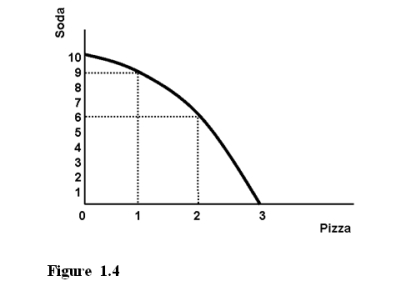
A)one unit of soda.
B)three units of soda.
C)six units of soda.
D)the same as the opportunity cost of producing the first unit of pizza.

A)one unit of soda.
B)three units of soda.
C)six units of soda.
D)the same as the opportunity cost of producing the first unit of pizza.

Unlock Deck
Unlock for access to all 124 flashcards in this deck.
Unlock Deck
k this deck
50
Referring to Figure 1.5, the opportunity cost of producing the first unit of pizza is 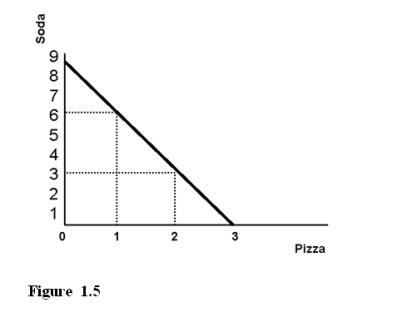
A)one unit of soda.
B)three units of soda.
C)six units of soda.

A)one unit of soda.
B)three units of soda.
C)six units of soda.

Unlock Deck
Unlock for access to all 124 flashcards in this deck.
Unlock Deck
k this deck
51
Referring to Figure 1.4, the opportunity cost of producing the third unit of pizza is 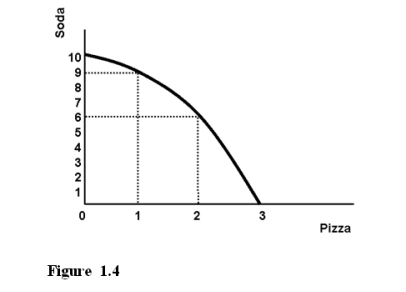
A)one unit of soda.
B)three units of soda.
C)six units of soda.
D)the same as the opportunity cost of producing the first unit of pizza.

A)one unit of soda.
B)three units of soda.
C)six units of soda.
D)the same as the opportunity cost of producing the first unit of pizza.

Unlock Deck
Unlock for access to all 124 flashcards in this deck.
Unlock Deck
k this deck
52
Referring to Figure 1.5, the opportunity cost of producing the third unit of pizza is 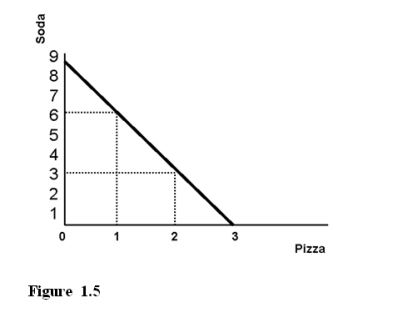
A)one unit of soda.
B)three units of soda.
C)six units of soda.

A)one unit of soda.
B)three units of soda.
C)six units of soda.

Unlock Deck
Unlock for access to all 124 flashcards in this deck.
Unlock Deck
k this deck
53
Using Figure 1.5 above we know the production of 6 units of soda and 2 units of pizza is 
A)possible, but there would be unemployed resources.
B)possible, but only if all resources were fully employed.
C)impossible because we either do not have the resources or the technology.
D)undesirable.

A)possible, but there would be unemployed resources.
B)possible, but only if all resources were fully employed.
C)impossible because we either do not have the resources or the technology.
D)undesirable.

Unlock Deck
Unlock for access to all 124 flashcards in this deck.
Unlock Deck
k this deck
54
Using Figure 1.6 you can tell that 
A)the technology does not exist to produce 130 units of soda and 1 unit of pizza.
B)there is unemployment.
C)there is constant opportunity cost.
D)the technology does not exist to produce 90 units of soda and 3 units of pizza.

A)the technology does not exist to produce 130 units of soda and 1 unit of pizza.
B)there is unemployment.
C)there is constant opportunity cost.
D)the technology does not exist to produce 90 units of soda and 3 units of pizza.

Unlock Deck
Unlock for access to all 124 flashcards in this deck.
Unlock Deck
k this deck
55
Using Figure 1.6 we know the production of 90 units of soda and 4 units of pizza is 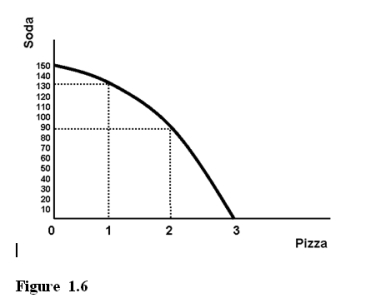
A)possible, but there would be unemployed resources.
B)possible, but only if all resources were fully employed.
C)impossible because we either do not have the resources or the technology.
D)undesirable.

A)possible, but there would be unemployed resources.
B)possible, but only if all resources were fully employed.
C)impossible because we either do not have the resources or the technology.
D)undesirable.

Unlock Deck
Unlock for access to all 124 flashcards in this deck.
Unlock Deck
k this deck
56
Referring to Figure 1.5, the opportunity cost of producing the second unit of pizza is 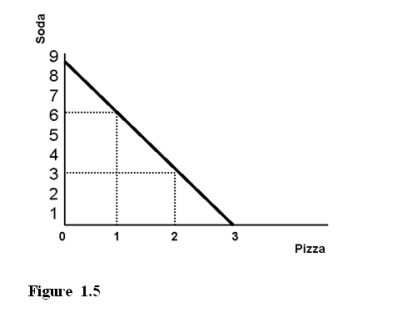
A)one unit of soda.
B)three units of soda.
C)six units of soda.

A)one unit of soda.
B)three units of soda.
C)six units of soda.

Unlock Deck
Unlock for access to all 124 flashcards in this deck.
Unlock Deck
k this deck
57
Using Figure 1.5 above you can tell that 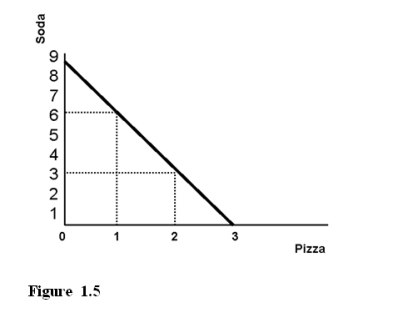
A)the technology does not exist to produce 4 units of soda and 1 unit of pizza.
B)there is unemployment.
C)there is increasing opportunity cost.
D)the technology does not exist to produce 3 units of soda and 3 unit of pizza.

A)the technology does not exist to produce 4 units of soda and 1 unit of pizza.
B)there is unemployment.
C)there is increasing opportunity cost.
D)the technology does not exist to produce 3 units of soda and 3 unit of pizza.

Unlock Deck
Unlock for access to all 124 flashcards in this deck.
Unlock Deck
k this deck
58
Using Figure 1.5 above we know the production of 2 units of soda and 2 units of pizza is 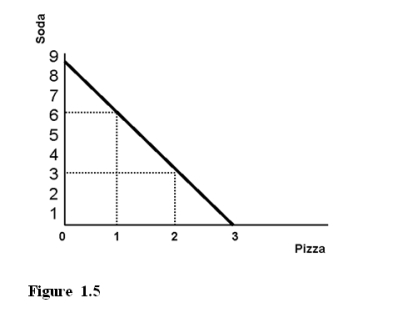
A)possible, but there would be unemployed resources.
B)possible, but only if all resources were fully employed.
C)impossible because we have the resources but do not have the technology.
D)impossible because we have the technology but do not have the resources.

A)possible, but there would be unemployed resources.
B)possible, but only if all resources were fully employed.
C)impossible because we have the resources but do not have the technology.
D)impossible because we have the technology but do not have the resources.

Unlock Deck
Unlock for access to all 124 flashcards in this deck.
Unlock Deck
k this deck
59
Using Figure 1.6 we know the production of 90 units of soda and 1 units of pizza is 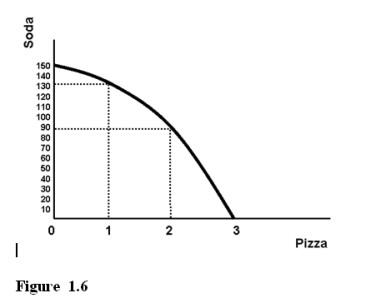
A)possible, but there would be unemployed resources.
B)possible, but only if all resources were fully employed.
C)impossible because we have the resources but do not have the technology.
D)impossible because we have the technology but do not have the resources.

A)possible, but there would be unemployed resources.
B)possible, but only if all resources were fully employed.
C)impossible because we have the resources but do not have the technology.
D)impossible because we have the technology but do not have the resources.

Unlock Deck
Unlock for access to all 124 flashcards in this deck.
Unlock Deck
k this deck
60
Using Figure 1.5 above we know the production of 3 units of soda and 2 units of pizza is 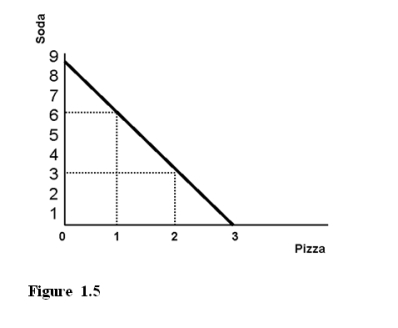
A)possible, but there would be unemployed.
B)possible, but only if all resources were fully employed.
C)impossible because we have the resources but do not have the technology.
D)impossible because we have the technology but do not have the resources.

A)possible, but there would be unemployed.
B)possible, but only if all resources were fully employed.
C)impossible because we have the resources but do not have the technology.
D)impossible because we have the technology but do not have the resources.

Unlock Deck
Unlock for access to all 124 flashcards in this deck.
Unlock Deck
k this deck
61
Imagine an economist ordering pizza by the slice. When deciding how many slices to order she would pick that number where the enjoyment of the _____ equals the enjoyment she could get from using the money on another good.
A)first slice
B)last slice
C)average slice
D)total number of slices
A)first slice
B)last slice
C)average slice
D)total number of slices

Unlock Deck
Unlock for access to all 124 flashcards in this deck.
Unlock Deck
k this deck
62
Of course, all individual students are better off if they get better grades. If you were to conclude that all students would be better off if everyone received an "A" you would
A)have fallen victim to the fallacy of scarcity.
B)be right.
C)have fallen victim to the fallacy of composition.
D)be mistaking correlation with causation.
A)have fallen victim to the fallacy of scarcity.
B)be right.
C)have fallen victim to the fallacy of composition.
D)be mistaking correlation with causation.

Unlock Deck
Unlock for access to all 124 flashcards in this deck.
Unlock Deck
k this deck
63
The fact that snow cones sales fall when snow accumulated from the sky suggests that snow cones sales and snow on the ground are
A)directly correlated.
B)inversely correlated.
C)neither directly correlated nor inversely correlated.
D)both directly correlated and inversely correlated.
A)directly correlated.
B)inversely correlated.
C)neither directly correlated nor inversely correlated.
D)both directly correlated and inversely correlated.

Unlock Deck
Unlock for access to all 124 flashcards in this deck.
Unlock Deck
k this deck
64
Referring to Figure 1.9, if a point represents unemployment it is in 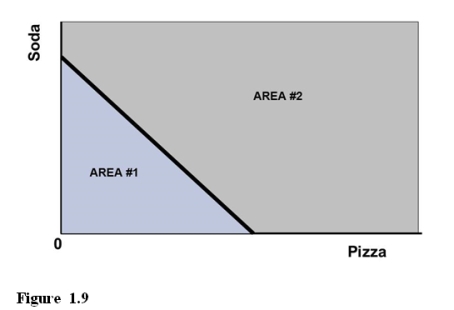
A)AREA #1 but not on the curve.
B)AREA #1 or is on the curve.
C)AREA #2 but not on the curve.
D)AREA #2 or is on the curve.

A)AREA #1 but not on the curve.
B)AREA #1 or is on the curve.
C)AREA #2 but not on the curve.
D)AREA #2 or is on the curve.

Unlock Deck
Unlock for access to all 124 flashcards in this deck.
Unlock Deck
k this deck
65
Economic incentives can come from
A)markets.
B)government programs.
C)taxes.
D)all of the options are correct.
A)markets.
B)government programs.
C)taxes.
D)all of the options are correct.

Unlock Deck
Unlock for access to all 124 flashcards in this deck.
Unlock Deck
k this deck
66
Logging companies are always more profitable if they are able to harvest more (rather than less)lumber in a month. If you concluded from that fact that the logging industry is more profitable if all of the firms in the industry harvest more, then you would be
A)right.
B)wrong because causation and correlation are not the same.
C)wrong and have fallen victim to the fallacy of composition.
D)wrong because firms operate on jealousy.
A)right.
B)wrong because causation and correlation are not the same.
C)wrong and have fallen victim to the fallacy of composition.
D)wrong because firms operate on jealousy.

Unlock Deck
Unlock for access to all 124 flashcards in this deck.
Unlock Deck
k this deck
67
Using Figure 1.7 we know the production of 5 units of soda and 2 units of pizza is 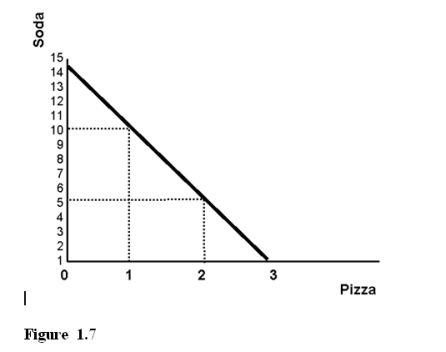
A)possible, but there would be unemployed resources.
B)possible, but only if all resources were fully employed.
C)impossible because we have the resources but do not have the technology.
D)impossible because we have the technology but do not have the resources.

A)possible, but there would be unemployed resources.
B)possible, but only if all resources were fully employed.
C)impossible because we have the resources but do not have the technology.
D)impossible because we have the technology but do not have the resources.

Unlock Deck
Unlock for access to all 124 flashcards in this deck.
Unlock Deck
k this deck
68
Using Figure 1.7 we know the production of 10 units of soda and 2 units of pizza is 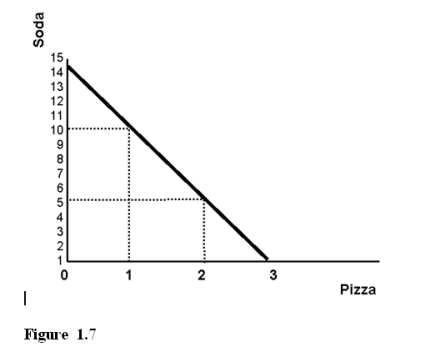
A)possible, but there would be unemployed resources.
B)possible, but only if all resources were fully employed.
C)impossible because we either do not have the resources or the technology.
D)undesirable.

A)possible, but there would be unemployed resources.
B)possible, but only if all resources were fully employed.
C)impossible because we either do not have the resources or the technology.
D)undesirable.

Unlock Deck
Unlock for access to all 124 flashcards in this deck.
Unlock Deck
k this deck
69
Every worker is better off making more money and having better benefits. If you concluded from that fact that all workers would be better off if a law were passed requiring a 25% increase in wages and benefits, then you would be
A)right.
B)wrong because causation and correlation are not the same.
C)wrong and have fallen victim to the fallacy of composition.
D)wrong because workers operate on jealousy.
A)right.
B)wrong because causation and correlation are not the same.
C)wrong and have fallen victim to the fallacy of composition.
D)wrong because workers operate on jealousy.

Unlock Deck
Unlock for access to all 124 flashcards in this deck.
Unlock Deck
k this deck
70
Using Figure 1.7 we know the production of 10 units of soda and 1 unit of pizza is 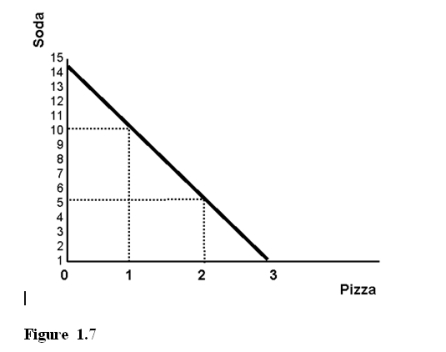
A)possible, but there would be unemployed resources.
B)possible, but only if all resources were fully employed.
C)impossible because we have the resources but do not have the technology.
D)impossible because we have the technology but do not have the resources.

A)possible, but there would be unemployed resources.
B)possible, but only if all resources were fully employed.
C)impossible because we have the resources but do not have the technology.
D)impossible because we have the technology but do not have the resources.

Unlock Deck
Unlock for access to all 124 flashcards in this deck.
Unlock Deck
k this deck
71
Referring to Figure 1.8, if a point is attainable it is in 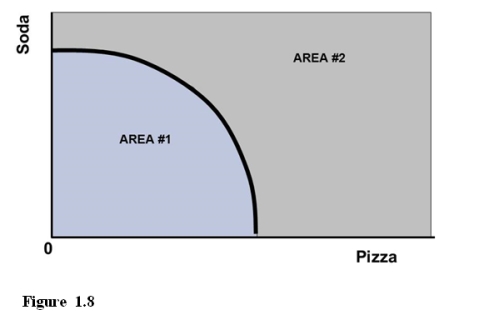
A)AREA #1 but not on the curve.
B)AREA #1 or is on the curve.
C)AREA #2 but not on the curve.
D)AREA #2 or is on the curve.

A)AREA #1 but not on the curve.
B)AREA #1 or is on the curve.
C)AREA #2 but not on the curve.
D)AREA #2 or is on the curve.

Unlock Deck
Unlock for access to all 124 flashcards in this deck.
Unlock Deck
k this deck
72
Referring to Figure 1.9, if a point is unattainable it is in 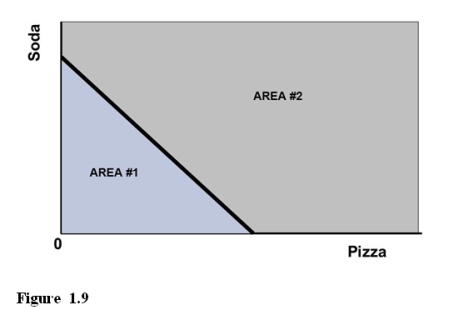
A)AREA #1 but not on the curve.
B)AREA #1 or is on the curve.
C)AREA #2 but not on the curve.
D)AREA #2 or is on the curve.

A)AREA #1 but not on the curve.
B)AREA #1 or is on the curve.
C)AREA #2 but not on the curve.
D)AREA #2 or is on the curve.

Unlock Deck
Unlock for access to all 124 flashcards in this deck.
Unlock Deck
k this deck
73
An economist, when analyzing a problem will attempt to
A)maximize the net benefit of an action and this occurs where the marginal benefit equals the marginal cost.
B)maximize the total benefit of an action.
C)minimize the total cost of an action.
D)maximize the net benefit of an action and this occurs where the average benefit equals the average cost.
A)maximize the net benefit of an action and this occurs where the marginal benefit equals the marginal cost.
B)maximize the total benefit of an action.
C)minimize the total cost of an action.
D)maximize the net benefit of an action and this occurs where the average benefit equals the average cost.

Unlock Deck
Unlock for access to all 124 flashcards in this deck.
Unlock Deck
k this deck
74
Many forms of seafood (lobster, crab legs etc.)are consumed by dipping the meat in melted garlic butter. If someone suggested that it would therefore be equally appealing to drink melted butter after having eaten garlic and unseasoned seafood, you would know they had fallen victim to which of the following?
A)the fallacy that correlation is the same as causation
B)the fallacy of composition
C)a logical tautology
D)none of the options are correct
A)the fallacy that correlation is the same as causation
B)the fallacy of composition
C)a logical tautology
D)none of the options are correct

Unlock Deck
Unlock for access to all 124 flashcards in this deck.
Unlock Deck
k this deck
75
Using Figure 1.7 we know the production of 4 units of soda and 2 units of pizza is 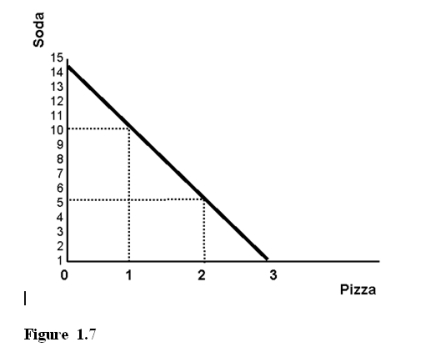
A)possible, but there would be unemployed resources.
B)possible, but only if all resources were fully employed.
C)impossible because we have the resources but do not have the technology.
D)impossible because we have the technology but do not have the resources.

A)possible, but there would be unemployed resources.
B)possible, but only if all resources were fully employed.
C)impossible because we have the resources but do not have the technology.
D)impossible because we have the technology but do not have the resources.

Unlock Deck
Unlock for access to all 124 flashcards in this deck.
Unlock Deck
k this deck
76
The statement that "since a farmer will make more money if he has a bumper crop means that all farmers would make more money if they all had bumper crops" would be an example of which of the following?
A)the fallacy that correlation is the same as causation
B)the fallacy of composition
C)truth in an obvious form
D)A)and B)
A)the fallacy that correlation is the same as causation
B)the fallacy of composition
C)truth in an obvious form
D)A)and B)

Unlock Deck
Unlock for access to all 124 flashcards in this deck.
Unlock Deck
k this deck
77
An economist, when analyzing a problem will compare the ___ and choose the outcome where they are equal
A)average benefits to the average costs
B)marginal benefits to the marginal costs
C)total benefits to the total costs
D)fixed benefits to the fixed costs
A)average benefits to the average costs
B)marginal benefits to the marginal costs
C)total benefits to the total costs
D)fixed benefits to the fixed costs

Unlock Deck
Unlock for access to all 124 flashcards in this deck.
Unlock Deck
k this deck
78
Referring to Figure 1.8, if a point represents unemployment it is in 
A)AREA #1 but not on the curve.
B)AREA #1 or is on the curve.
C)AREA #2 but not on the curve.
D)AREA #2 or is on the curve.

A)AREA #1 but not on the curve.
B)AREA #1 or is on the curve.
C)AREA #2 but not on the curve.
D)AREA #2 or is on the curve.

Unlock Deck
Unlock for access to all 124 flashcards in this deck.
Unlock Deck
k this deck
79
Referring to Figure 1.9, if a point is attainable it is in 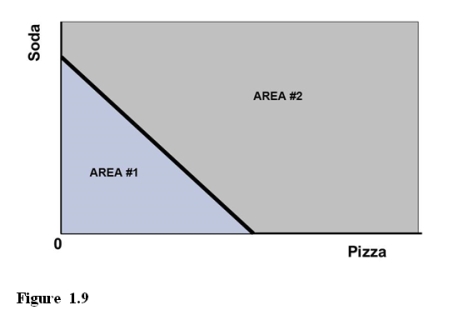
A)AREA #1 but not on the curve.
B)AREA #1 or is on the curve.
C)AREA #2 but not on the curve.
D)AREA #2 or is on the curve.

A)AREA #1 but not on the curve.
B)AREA #1 or is on the curve.
C)AREA #2 but not on the curve.
D)AREA #2 or is on the curve.

Unlock Deck
Unlock for access to all 124 flashcards in this deck.
Unlock Deck
k this deck
80
Referring to Figure 1.8, if a point is unattainable it is in 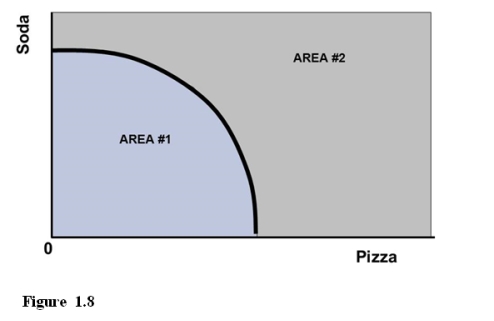
A)AREA #1 but not on the curve.
B)AREA #1 or is on the curve.
C)AREA #2 but not on the curve.
D)AREA #2 or is on the curve.

A)AREA #1 but not on the curve.
B)AREA #1 or is on the curve.
C)AREA #2 but not on the curve.
D)AREA #2 or is on the curve.

Unlock Deck
Unlock for access to all 124 flashcards in this deck.
Unlock Deck
k this deck



